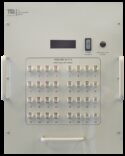Experiment
H313V

Advanced HYDROLOGY AND RAINFALL APPARATUS
A self contained floor standing unit consisting of a water reservoir and a tank for sand with overhead spray nozzles that simulate rainfall both stationary and moving. It is for studying hydrology principals including rainfall, throughflow and the movement of water over land and rivers.
If you have any questions or you'd like to discuss a product, please call us.
+44 1159 722 611Advanced HYDROLOGY AND RAINFALL APPARATUS
The apparatus is a sturdy metal frame which holds a large rectangular stainless-steel tank (catchment area) and a reservoir tank. Students can fill the catchment area with a granular medium (available separately) to form a permeable catchment area.
A jacking mechanism allows adjustment of the angle of the catchment area. Above the catchment area is a frame that holds spray nozzles which simulate rainfall on the catchment. A valve selects all or half the nozzles. Students can use this facility to vary the lag time on a hydrograph or to simulate a moving storm.
At each end of the catchment area are end compartments, separated from the catchment by weir plates with porous ‘port holes’. Students can open the port holes to drain water from the catchment area, or to supply water to it from the end compartments.
In the middle of the catchment area are two ‘wells’ for experiments with water wells. A row of 20 tappings along the centre line of the catchment area allows students to measure the water table profile. Each tapping has special slotted ends to stop the permeable media entering its pipe. The tappings connect to a bank of piezometer tubes at the front of the catchment area.
A pump takes water from the reservoir and feeds it to the overhead nozzles and to the ends of the catchment area. Students can vary the flow to the nozzles and tank. A flow meter measures the overall flow.
Students can use a calibrated rectangular weir under the catchment area to measure flow from the wells or the tank.
The apparatus is completely self-contained and needs only a mains electrical supply. The permeable medium is not included with the apparatus, but TecQuipment offers a suitable grade of sand as an ancillary.
Learning outcomes
- Investigation of rainfall/run-off relationships for dry, saturated and impermeable catchments of various slopes (surface run-off only)
- Effect of interflow on outflow hydrograph surface runoff (plus groundwater flow)
- Simulation of multiple and moving storms
- Measurement of cone of depression for a single well and comparison with theory interaction of cones of depression for two adjacent wells
- De-watering of excavation sites by use of wells
- Flow from a well in a confined aquifer
- Demonstration of watersheds for a simulated island with rainfall and well flows
- Sediment transport and meanders in simulated rivers
- Studies of scour around simulated bridge piers
- Demonstration of erosion caused by water through flow









